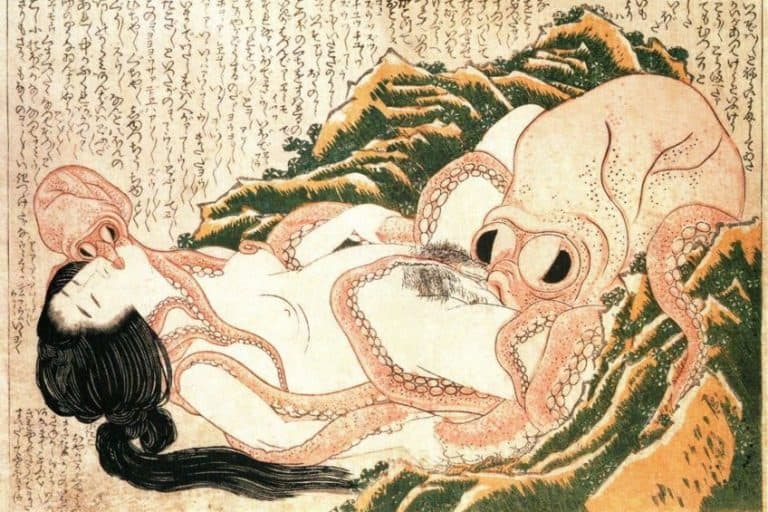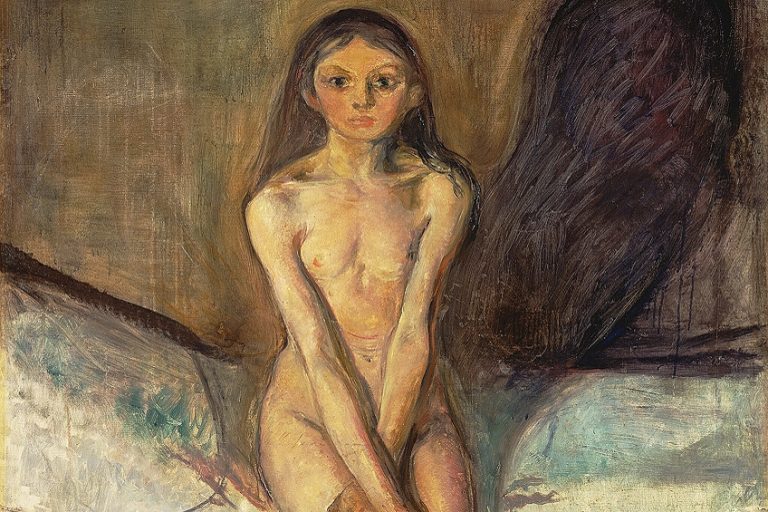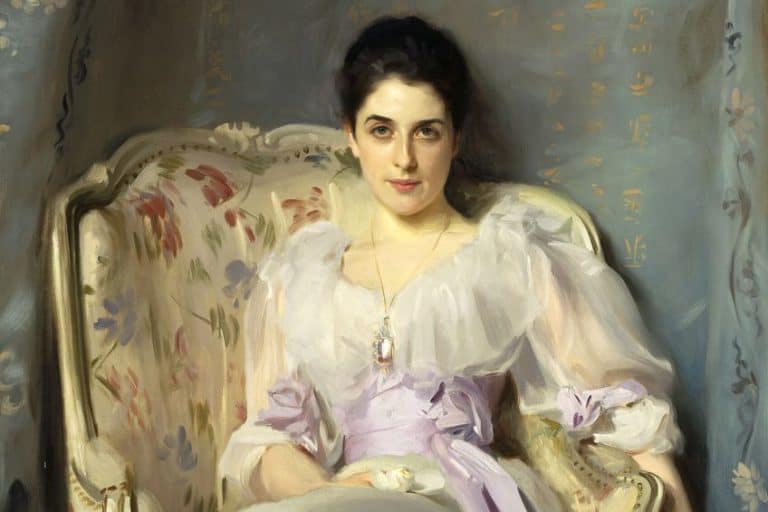“Two Sisters (On the Terrace)” by Pierre-Auguste Renoir – A Look
Pierre-Auguste Renoir was among the Impressionist group of artists during the 19th century. He has a rich history, filled with experiences and connections that all molded and made him the prolific artist he was. This article will take us to one of his favorite spots, exploring his painting titled Two Sisters (On the Terrace) (1881) in more detail.
Artist Abstract: Who Was Pierre-Auguste Renoir?
Pierre-Auguste Renoir was an Impressionist painter born in Limoges, Haute-Vienne in France, but also grew up in Paris. His birth and death dates are February 25, 1841, and December 3, 1919. He was artistic from a young age, from visual arts to music, and he also worked in a porcelain factory during his teenage years. Some of his prominent education sources included the École des Beaux-Arts and Charles Gleyre.
Renoir’s subject matter often included scenes of leisure and festivity, as well as female nudes and self-portraits, for example, “Diana” (1867), “Luncheon of the Boating Party” (1881), and “Self-Portrait” (1910).

Two Sisters (On the Terrace) (1881) by Pierre-Auguste Renoir in Context
| Artist | Pierre-Auguste Renoir (1841 – 1919) |
| Date Painted | 1881 |
| Medium | Oil on canvas |
| Genre | Genre painting |
| Period / Movement | Impressionism |
| Dimensions (cm) | 100.4 x 80.9 |
| Series / Versions | N/A |
| Where Is It Housed? | Art Institute of Chicago, Illinois, United States |
| What It Is Worth | Purchased for 1, 500 francs by Paul Durand-Ruel in 1881, and then for $100,000 in 1925 by Annie Swan Coburn. It was given to the Art Institute of Chicago in 1933. |
This article will discuss Pierre-Auguste Renoir’s Two Sisters (On the Terrace) analysis in more detail, starting with a brief contextual analysis around what inspired this oil on canvas and a look at his artistic style categorized around the art elements and principles of design.
Contextual Analysis: A Brief Socio-Historical Overview
Two Sisters (On the Terrace) by Pierre-Auguste Renoir is set in Chatou, a Parisian suburb, where the island Île des Impressionnistes in the Seine River is located and the location of Maison Fournaise. The Maison Fournaise, which was established by Alphonse Fournaise who bought it in 1857, was not only a hotspot for boaters but diners and hotel goers alike; the restaurant was established in 1860 and became a famous gathering place for various types of people especially artists like Renoir.
The Maison Fournaise was almost like a muse to Renoir and inspired his art making. He reportedly painted around or over 30 scenes depicting different settings at this location, from the people to the surrounding environment.
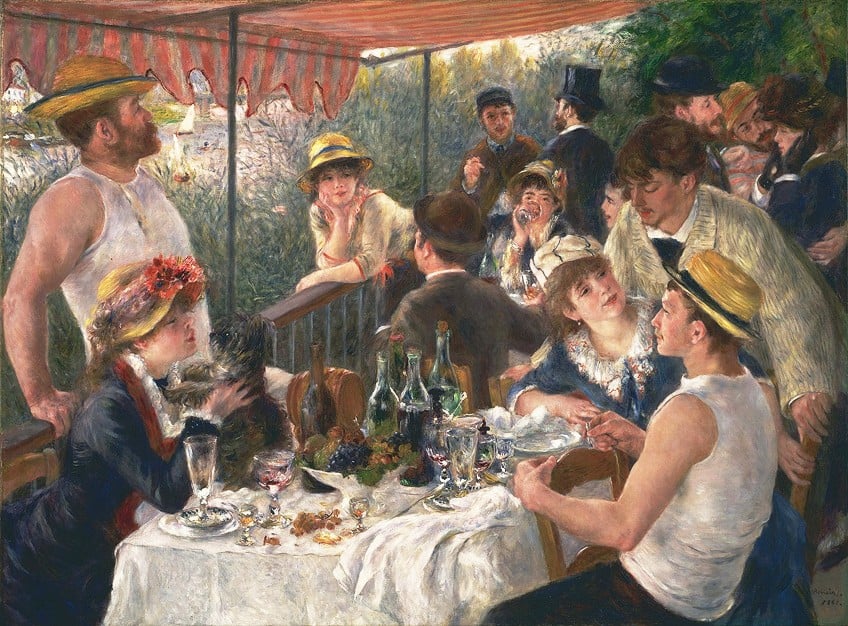
He started painting this theme around 1868 and spent several years frequenting his favorite spot until around 1884. You might recall Luncheon of the Boating Party (1881), which was one of Renoir’s more well-known paintings depicting numerous people at the Maison Fournaise, socializing, dining, and enjoying a leisurely time. Interestingly, among the people, Renoir depicted Alphonse Fournaise’s daughter, Louise-Alphonsine Fournaise, and son, Alphonse Fournaise, Jr., as the two figures leaned against the railing to the left.
Who Were the Two Sisters?
An interesting fact about Two Sisters (On the Terrace) by Pierre-Auguste Renoir is that the two sisters were probably not sisters in real life and could have only been models for the artist. The young woman to the left is the only model who has been identified and is believed to be the French Jeanne Darlot; she was known as an actress.
Formal Analysis: A Brief Compositional Overview
In the formal analysis you will learn more about the artistic style of Two Sisters (On the Terrace) by Pierre-Auguste Renoir, which will be explored according to the main art elements with mention how various principles of design are also applied.

Subject Matter: Visual Description
Two Sisters (On the Terrace) by Pierre-Auguste Renoir depicts two female figures, one appears to be in her late teenage years and the other is still a child. They are both on a terrace facing us (the viewers). The background depicts an outdoor scene and more specifically it is the location of the Maison Fournaise, which is a restaurant on the island called Île des Impressionnistes in the Seine River in the suburb called Chatou.
The older female is seated and slightly hunched over with her hands folded in her lap and her eyes focused on her right; she appears musing.

The terrace’s railing is directly behind her. The younger girl is standing to her right looking directly at us with both her hands holding onto the edge of a basket filled with different colors of woolen balls, which is on a small table in the bottom left corner of the composition and in front of her and the young woman.
Color
While there is a rich variety of hues and contrasts created by Renoir in Two Sisters (On the Terrace), a brief indication of how he utilized color includes the contrasts between the softer earthier colors like the greens and blues that compose the trees, plants, and river’s water in the background to the more brilliant, but deeper shade of blue of the young woman’s dress and the red of her hat.
Additionally, the beautiful blues of the child’s eyes, the collars over her shoulders, the florals on her hat, and the balls of wool also add to the brilliance of colors in the foreground.

Texture
Renoir’s brushstrokes have been described as looser in the background and more ordered in the foreground, for example in the female figures’ smooth skin tones. There is a variation of the types of brushstrokes, for example, the background consists of choppy, short, and thick strokes for the trees’ leaves and thinner and longer strokes for the tree trunks and vines around the terrace’s railing.
The brushstrokes in the foreground are denser in their application, especially for the young women’s clothing, which creates further contrast.
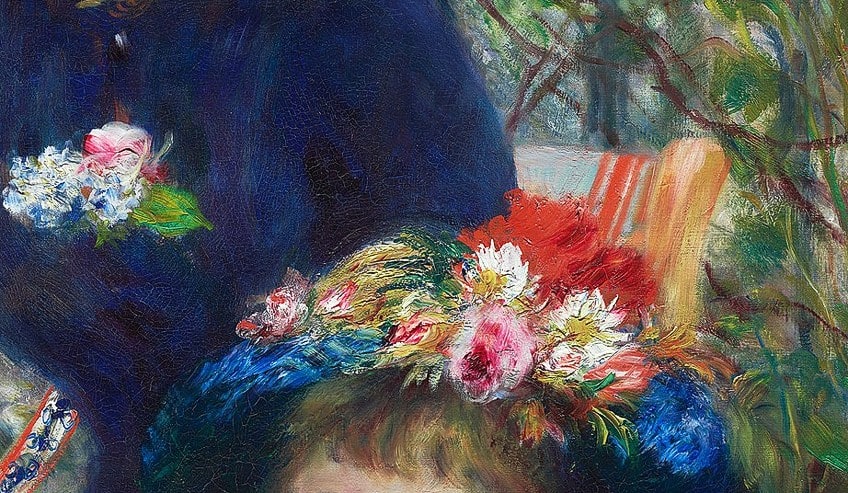
Line
There is a variety in the types of lines in Two Sisters (On the Terrace) by Pierre-Auguste Renoir, and these are natural (also termed organic) lines, which are more fluid in delineation. Some of the lines appear as curved, curling, and rounded for example in the figures and natural environment around them.
There are also some geometric lines evident in the verticality from the railing as well as the buildings far into the distant background to the upper left corner.
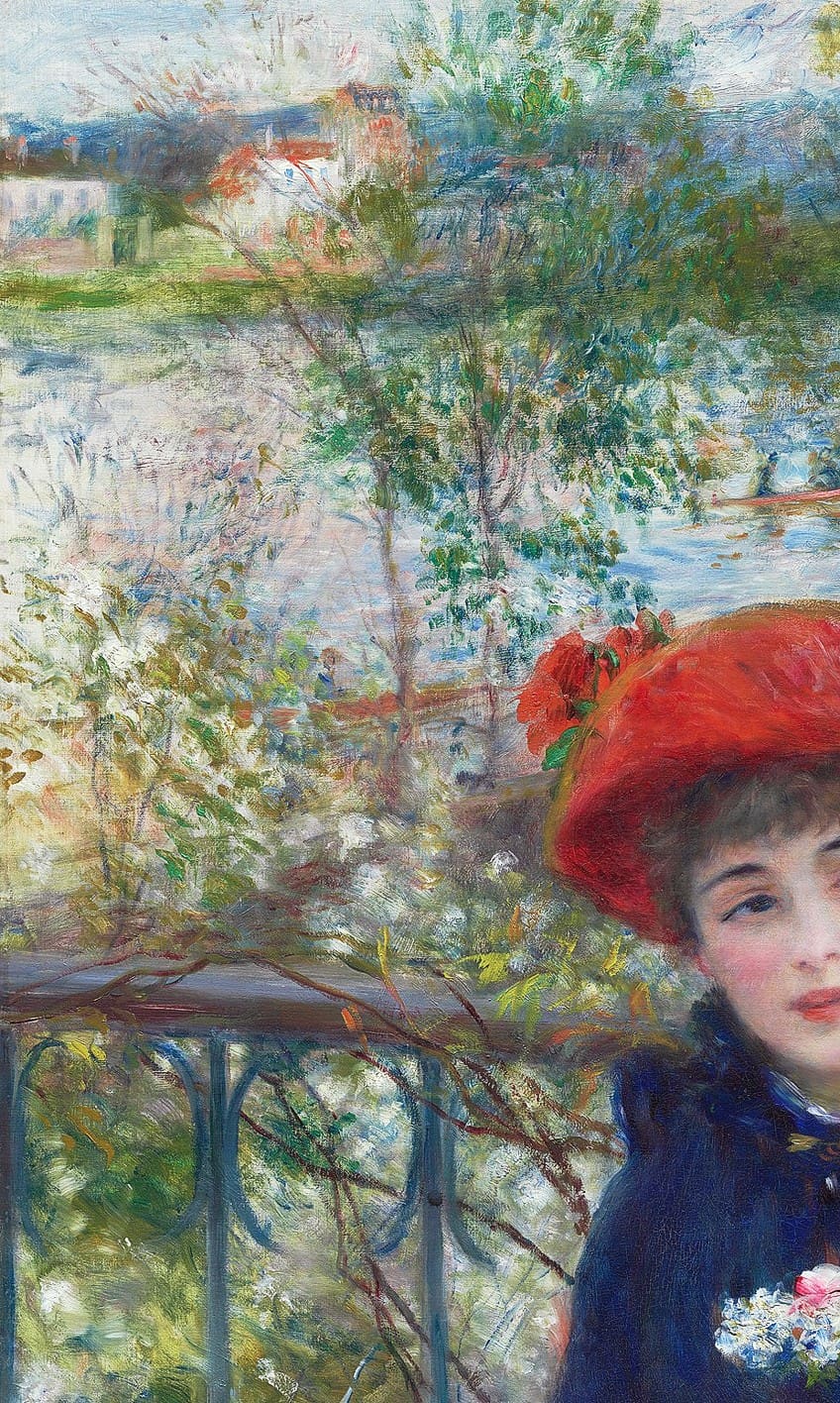
Shape and Form
Like the above-mentioned naturalism found in the lines, there is also a naturalism of shape and form in Two Sisters (On the Terrace) by Pierre-Auguste Renoir. There is an “asymmetrical” quality to the subject matter and the figures and natural environments appear more curved and freer flowing.
This can be compared to geometric shapes and forms that would appear more structured or symmetrical.

Space
Renoir placed the two female figures in the near foreground and depicted a beautiful scenery of the Seine behind them, which composes the background. Furthermore, the slightly horizontal line implied by the railing from the terrace moves the figures further into the foreground, placing emphasis on them as the focal point.

Exploring Renoir’s Favorite Spot
The value of the Two Sisters (On the Terrace) painting far exceeds the price paid for it over the years. It is not only a painting depicting two sisters, as coined by the artist but a moment in time when Renoir lived and enjoyed himself at one of his favorite places. It is a window onto ways of leisure and dining during the 19th century.
That brings us to the end of our “Two Sisters (On the Terrace)” analysis, which was painted by Pierre-Auguste Renoir in 1881. It explored the significance of place in Renoir’s choice of subject matter, as well as the real relation between the two girls depicted, followed by a brief formal analysis of Renoir’s artistic approach.
Frequently Asked Questions
Who Painted Two Sisters (On the Terrace)?
The French Impressionist artist Pierre-Auguste Renoir painted the oil on canvas work titled Two Sisters (On the Terrace) (1881). This was one of approximately 30 paintings that explored the same place that Renoir frequented, which was the Maison Fournaise in France.
Are Two Sisters and On the Terrace Different Paintings?
No, Two Sisters (On the Terrace) (1881) by Pierre-Auguste Renoir was initially titled Two Sisters by the artist and additionally titled On the Terrace by Paul Durand-Ruel, who bought the painting for 1,500 francs in 1881.
Where Is the Painting Two Sisters (On the Terrace) Housed?
Two Sisters (On the Terrace) (1881) by Pierre-Auguste Renoir is held at the Art Institute of Chicago in Illinois, United States. It was given to the art museum in 1933 by Annie Swan Coburn, from her art collection.
What Is the Value of the Two Sisters (On the Terrace) Painting?
The Two Sisters (On the Terrace) (1881) by Pierre-Auguste Renoir was first purchased for 1, 500 francs by Paul Durand-Ruel in 1881, and subsequently purchased by Annie Swan Coburn for $100,000 in 1925.
Alicia du Plessis is a multidisciplinary writer. She completed her Bachelor of Arts degree, majoring in Art History and Classical Civilization, as well as two Honors, namely, in Art History and Education and Development, at the University of KwaZulu-Natal, South Africa. For her main Honors project in Art History, she explored perceptions of the San Bushmen’s identity and the concept of the “Other”. She has also looked at the use of photography in art and how it has been used to portray people’s lives.
Alicia’s other areas of interest in Art History include the process of writing about Art History and how to analyze paintings. Some of her favorite art movements include Impressionism and German Expressionism. She is yet to complete her Masters in Art History (she would like to do this abroad in Europe) having given it some time to first develop more professional experience with the interest to one day lecture it too.
Alicia has been working for artincontext.com since 2021 as an author and art history expert. She has specialized in painting analysis and is covering most of our painting analysis.
Learn more about Alicia du Plessis and the Art in Context Team.
Cite this Article
Alicia, du Plessis, ““Two Sisters (On the Terrace)” by Pierre-Auguste Renoir – A Look.” Art in Context. May 16, 2023. URL: https://artincontext.org/two-sisters-on-the-terrace-by-pierre-auguste-renoir/
du Plessis, A. (2023, 16 May). “Two Sisters (On the Terrace)” by Pierre-Auguste Renoir – A Look. Art in Context. https://artincontext.org/two-sisters-on-the-terrace-by-pierre-auguste-renoir/
du Plessis, Alicia. ““Two Sisters (On the Terrace)” by Pierre-Auguste Renoir – A Look.” Art in Context, May 16, 2023. https://artincontext.org/two-sisters-on-the-terrace-by-pierre-auguste-renoir/.





